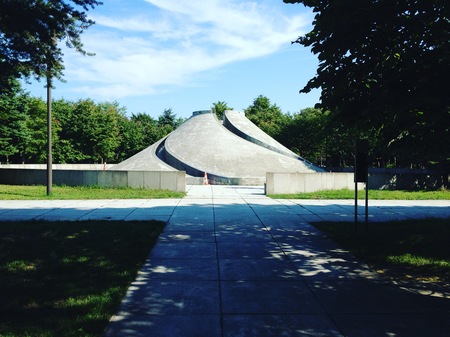動線空間の起こり
20世紀以降、人間のアクティビティーが建築を支配している、とした。
人間のアクティビティーの中で一番単純で、初歩的で、誰でも行うことが「歩く」こと。「歩く」ことを建築化すると、廊下、階段、スロープなど動線空間と呼ばれる空間になる。
この動線空間が建築の中で主体的に扱われるようになったのが20世紀以降ではないだろうか。昔の宮殿や伽藍には回廊と呼ばれる動線空間があったが、それはあくまでも主要な空間を結ぶためのもので、それが主体的な空間として扱われることはなかった、それは階段やスロープもしかり。
20世紀になり人間のアクティビティーが元となった機能主義の建築になると、アクティビティーそのものが建築空間になっていく。
会津にささえ堂という建築がある。複雑な二重らせんスロープで一方通行で上がり下がりをする。中にはたくさんの観音様があり、上がって下がったて一周してくるだけで、たくさんのご利益が得られることを目的にして18世紀に建てられた。これはまさに動線空間が主体的に扱われた事例で、20世紀より前だが、これはむしろ特殊な事例で、日常の中で動線空間が主体的に扱われた事例に出会うようになったのは、やはり20世紀以降ではないだろうか。
"Occurrence of flow line space"
Human activities have dominated architecture since the 20th century.
The simplest, rudimentary, and "walking" thing anyone can do in human activity. When we build "walking", it becomes a space called traffic line space, such as corridors, stairs, and slopes.
This movement line space became to be treated independently in architecture probably after the 20th century. In the old palaces and forts, there was a flow line space called a corridor, but it was only for connecting the main spaces, and it was not treated as a dominant space, it was a staircase or slope. .
When the 20th century becomes functionalist architecture based on human activities, activities themselves become architectural spaces.
Aizu has an architecture called a temple. Up and down in one way with a complex double helix slope. There are many kannons inside, and it was built in the 18th century for the purpose of obtaining a lot of benefits just by going up and down and going around. This is a case in which the flow line space is treated in a dominant manner, and it is before 20th century, but this is rather a special case, and a case in which the flow line space is dealt in the daily life is to be encountered Is it not after the twentieth century?

